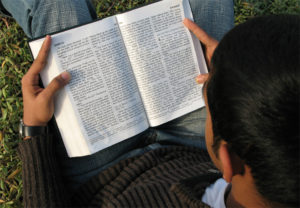
There are many forms of prayer through which we as a Catholic Christian Community pray. Except for the Mass (Eucharist) which is the highest form of prayer, whatever form we use depends on our tradition as well as our culture as we communicate with our God. That is what is important. We cannot have a meaningful relationship with anybody, including God, unless we communicate. The concluding sentence of my article on the Year of Faith was: Lectio Divina is a reading, reflecting, responding, and resting in the Word of God that helps one grow in a relationship with God.
I now quote from the pamphlet that explains Lectio Divina in more detail:
“Lectio Divina is the most traditional way of cultivating a relationship with Christ. It is a way of listening to the texts of scripture as if we were in conversation with Christ and He was suggesting the topics of conversation. It is listening with the ‘ear’ of the heart. The daily encounter with Christ and the reflection on His Word leads beyond mere acquaintanceship to an attitude of friendship, trust and love. Lectio Divina leads us to communion or as St. Gregory the Great, summarizing the Christian contemplative tradition says, ‘resting in God’”
Four Simple Steps to Pray with the Bible
That same pamphlet says the following under the title of guidelines for the Lectio Divina form of prayer:
- READ the passage. Listen with the ‘ear of the heart.’ What phrase, sentence or even one word stands out for you?
- Read the passage again and REFLECT on the word of God. Be aware of what touches you, a thought or reflection that is meaningful. Allow a minute of two of silence.
- Read the passage again and RESPOND spontaneously to the word of God. Be aware of any prayer that rises up within that expresses the experience. Allow a minute or two of silence.
- Read the passage a final time and REST in the word, reflect and pray and allow God to speak in the silence. Allow three or four minutes of silence.